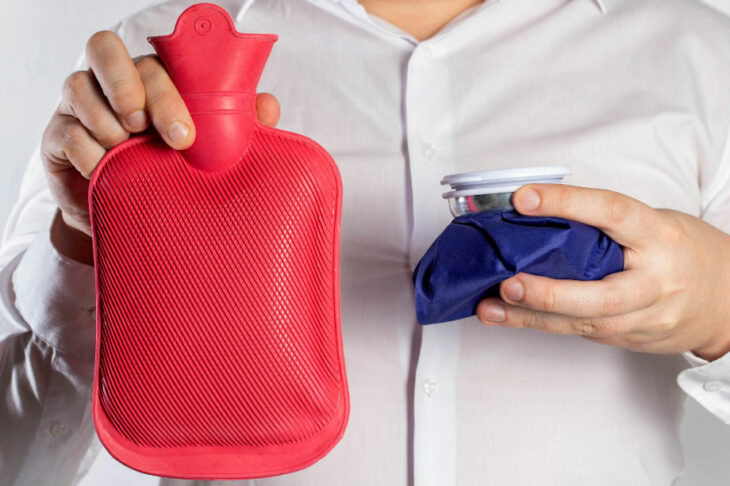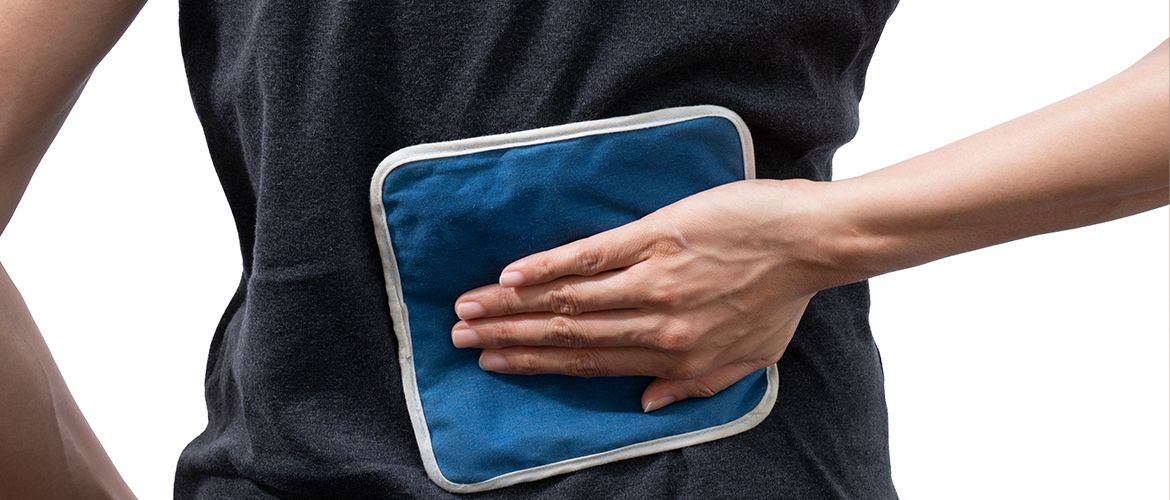Confuso sobre gelo ou calor? Esta é a maneira certa de tratar a dor
Andar de bicicleta é mais seguro do que praticar esportes de contato, mas você ainda pode sentir pequenas dores e incômodos. Aqui estão algumas dicas para quando seu corpo começar a doer.
Todos nós já usamos uma compressa de gelo ou ervilhas congeladas em uma pancada na cabeça, e quem fez um curso de primeiros socorros conhece a sigla ICE, que significa gelo, compressão e elevação. Mas e quanto ao uso de compressas quentes? E quanto ao tratamento de lesões alternando entre calor e frio?

Ao lidar com a dor, escolher entre terapia com gelo e terapia com calor pode ser confuso. Ambos os métodos têm benefícios, mas saber quando e como usar cada um pode realmente ajudar na sua recuperação.
Devo escolher gelo ou calor?
Quando usar calor

Aquecer-se durante o tratamento costuma ajudar nas seguintes situações:
Nódulos musculares: Quando você se esforça demais, se sente estressado ou tenso, seus músculos podem formar nós dolorosos. Aplicar calor pode ajudar a relaxar esses nós, aumentando o fluxo sanguíneo para a área dolorida.
Artrite: O calor, especialmente o calor úmido, pode ajudar a aliviar a rigidez articular causada pela artrite e reduzir a dor. Pessoas com osteoartrite crônica frequentemente relatam sentir-se melhor com o calor.
Cefaleias tensionais: Você às vezes se sente tão tenso que sua cabeça começa a doer? Um calor suave pode ajudar a relaxar os músculos tensos do pescoço e dos ombros, o que pode reduzir as dores de cabeça tensionais.
Tendinose: O calor é eficaz para aliviar a irritação e a rigidez causadas pela tendinose, uma condição crônica. No entanto, é importante aplicar o calor somente após a redução do inchaço.
Cólicas menstruais: Aplicar calor na região lombar ou no abdômen pode ajudar a aliviar as cólicas menstruais e a dor da menstruação.
Quando usar gelo

Se você estiver enfrentando alguma das seguintes situações, recorrer ao congelador pode ajudar:
Lesões agudas: Aplicar gelo pode ajudar a reduzir a dor e o inchaço se você torceu o tornozelo, machucou o dedo na porta ou bateu em alguma coisa. O ideal é começar a aplicar gelo imediatamente para obter melhores resultados.
Tendinite: Se você exagerou nos exercícios e sua tendinite está incomodando, usar gelo pode ajudar a reduzir o inchaço nos tendões, que são os tecidos que conectam os músculos aos ossos.
Crises de gota: Quando a gota causa dor e inchaço nas articulações, o uso de gelo pode ajudar a reduzir as crises e aliviar a dor. A terapia com frio é eficaz para esse tipo de artrite.
Dores de cabeça ou enxaquecas: Aplicar gelo ou compressas frias pode ajudar a aliviar uma forte dor de cabeça, reduzindo o inchaço e diminuindo a transmissão dos sinais de dor para o cérebro.
Febre: Colocar um pano frio na testa ou debaixo dos braços pode ajudar se a sua temperatura corporal subir para mais de 37 graus Celsius. No entanto, evite isso se a febre lhe causar sensação de frio.
Sangramento: Aplicar gelo contrai os vasos sanguíneos, o que pode ajudar a diminuir o sangramento e permitir a formação de coágulos em uma ferida. O uso de gelo combinado com pressão é mais eficaz.
Em alguns casos, a alternância entre gelo e calor, conhecida como terapia de contraste, pode ser benéfica, especialmente para certas lesões ou na recuperação pós-exercício.
Quais são os efeitos fisiológicos do gelo e do calor no corpo?
Terapia com gelo (crioterapia)
VasoconstriçãoO estreitamento dos vasos sanguíneos reduz o fluxo sanguíneo, minimizando o inchaço e a inflamação.
Efeito analgésico: Anestesia a área, diminuindo a sensação de dor.
Redução da taxa metabólica: Diminui o metabolismo celular, potencialmente limitando os danos aos tecidos.
Terapia de calor (termoterapia):
VasodilataçãoDilata os vasos sanguíneos, aumentando o fluxo sanguíneo e o fornecimento de oxigênio aos tecidos.
Relaxamento muscularReduz a tensão muscular e os espasmos.
Elasticidade tecidual aprimoradaMelhora a flexibilidade e a amplitude de movimento.
Ambas as terapias afetam o metabolismo dos tecidos, o fluxo sanguíneo, a inflamação e a flexibilidade dos tecidos conjuntivos, mas fazem isso de maneiras diferentes.
Quão importante é o momento certo?
O momento certo é crucial ao aplicar gelo ou calor:
Gelo
A aplicação de gelo é mais eficaz nas primeiras 48 horas após uma lesão. Nesse período, o gelo pode reduzir significativamente o inchaço e a dor. Nos estágios iniciais, ele age anestesiando a área lesionada e diminuindo o fluxo sanguíneo, contraindo os vasos sanguíneos. Por isso, o gelo é comumente usado logo após uma lesão para reduzir o inchaço e proporcionar alívio rápido. Além disso, é um tratamento fácil de aplicar imediatamente.
Aquecer
A longo prazo, aplicar calor em uma área afetada é uma ótima maneira de aliviar a dor causada por lesões crônicas, como espasmos musculares e rigidez articular. O calor ajuda a aumentar o fluxo sanguíneo, relaxar os músculos tensos e promover o relaxamento. Também diminui a dor causada pela rigidez articular.
Para a terapia de contraste, iniciar com terapia fria para reduzir a inflamação, seguida de calor para promover a cicatrização, pode ser particularmente eficaz.
Duração da candidatura
A duração adequada garante a eficácia e previne efeitos adversos:
Terapia com geloAplique por 15 a 20 minutos a cada 2 a 3 horas durante as primeiras 24 a 48 horas após a lesão. Sempre utilize uma barreira, como uma toalha, para proteger a pele.
Terapia de calorAplique por até 20 minutos, três vezes ao dia. Certifique-se de que a fonte de calor esteja morna, não quente, para evitar queimaduras. Você pode usar uma almofada térmica ou até mesmo uma simples bolsa de água quente, mas é importante envolvê-la em uma toalha ou algo protetor para não queimar a pele.
Há evidências sólidas da eficácia do calor e do gelo?
Estudos clínicos demonstraram a eficácia de ambas as terapias:
Terapia de calorEficaz na redução da dor e da incapacidade em pacientes com lombalgia aguda e dor muscular tardia (DOMS).
Terapia com geloEficaz na redução da temperatura e da inflamação dos tecidos, especialmente quando aplicado logo após a lesão.
Embora o gelo possa ser um tratamento imediato eficaz e continue sendo a primeira opção para lesões agudas, as evidências são conflitantes. Portanto, o gelo deve ser usado com moderação e apenas por um curto período. Isso ocorre porque ele pode atenuar o sinal enviado pelo processo inflamatório natural que inicia o reparo tecidual, atrasando assim o processo de cicatrização.
Há alguma precaução importante?
Embora geralmente seguro, certas precauções devem ser tomadas:
Evite o contato direto.Nunca aplique gelo ou calor diretamente na pele. Use uma barreira protetora para evitar queimaduras ou congelamento.
Monitorar a condição da peleSuspenda o uso se a pele ficar vermelha, com bolhas ou dormente.
Condições médicasIndivíduos com diabetes, doenças vasculares ou deficiências sensoriais devem consultar um profissional de saúde antes de usar essas terapias, pois a circulação sanguínea comprometida pode afetar a capacidade do corpo de regular a temperatura e se curar adequadamente.
Infecções e feridas abertasNão aplique calor sobre áreas com infecções ou feridas abertas.
Conclusão
Tanto a terapia com gelo quanto a com calor podem ser úteis para aliviar a dor e acelerar a recuperação, mas o segredo está em usá-las corretamente e no momento certo.O gelo é a melhor opção nos primeiros dias após uma lesão para reduzir o inchaço e aliviar a dor, enquanto o calor é mais indicado para rigidez, tensão ou dor crônica a longo prazo. Alternar entre os dois também pode ser eficaz, especialmente durante a recuperação de certas lesões ou treinos intensos.

Dito isso, por melhores que sejam essas terapias, a prevenção é sempre melhor que o tratamento. Portanto, seja você ciclista, corredor ou praticante de qualquer outro tipo de exercício, cuide do seu corpo. Aqueça-se adequadamente, respeite seus limites e não ignore os sinais que seu corpo lhe dá. Um pouco de cautela pode fazer toda a diferença para que você se mantenha saudável, ativo e livre de lesões.











